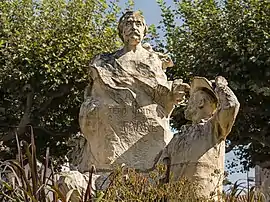Ferdinand Fabre
Biography
Ferdinand Fabre was born in Bédarieux in the upper valley of the Orb, in the department of Hérault, the setting for his novels. Under the influence of his mother, he entered the small seminary of Saint-Pons-de-Thomières and, in 1847, the large seminary of Montpellier. His uncle, a priest in Camplong, is mentioned in his books. The description of his experience in the ecclesiastical milieux provides one of the main themes of his novels.
In 1848, before taking his final vows, he abandoned his priestly vocation and briefly attempted the study of medicine in Montpellier. He then went to Paris and was articled as clerk to a lawyer. In 1861, shortly after his marriage, he became the Inspecteur de la Librarie Étrangère at the customs house in Calais.[4] He eventually left his civil service position and devoted himself entirely to literary work. He went to live in Paris where his social circle included many writers and artists. Among his closest friends was the writer Hector Malot. Fabre was also a close friend of the painter Jean-Paul Laurens, whose biography he wrote.
His daughter Valentine Clotilde Fabre was born in 1858 and died in 1942. She married Ferdinand Auguste Emile Duviard (1859–1949) and gave birth to a son Ferdinand Duviard (1889–1965), who became a writer and Esperantist, and a daughter Henriette Léonie Duviard (1895–1974).
He died in Paris, five days before his agreed-upon election to l'Académie française. In the 15th arrondissement de Paris, the Rue Ferdinand-Fabre is named in his honor.
His novel Le Chevrier (and the poem by Maurice Audubert-Boussat) inspired the 1925 opera Le Chevrier by Émile Goué. Fabre's novel Xavière inspired the 1895 opera Xavière by Théodore Dubois.
Selected works
- Feuilles de lierre (1853)
- Les Courbezon, scènes de la vie cléricale (1861), ouvrage distingué par l'Académie française
- Julien Savignac, scènes de la vie cléricale (1863)
- Mademoiselle de Malavieille (1865)
- Le Chevrier (1867)
- Un grand coupable (1872)
- L'Abbé Tigrane (1873) Texte en ligne
- Barnabé (1873)
- Le Marquis de Pierrerue (1874)
- La Petite Mère (1877)
- Le Roman d'un peintre (1878), biographie de Jean-Paul Laurens
- L'Hospitalière, drame rustique en cinq journées (1880)
- Mon Oncle Célestin, mœurs cléricales (1881), Lunas et la Saint-Fulcran de Lodève
- Lucifer (1884)
- Le Roi Ramire, comédie en 3 actes (1884)
- Monsieur Jean (1886)
- Toussaint Galabru (1887)
- Madame Fuster (1887)
- Œuvres de Ferdinand Fabre (4 volumes, 1888-1892) Texte en ligne (vol. 2)
- Ma Vocation (1889), séjour de l'auteur au séminaire de Montpellier Texte en ligne
- Norine (1889)
- Germy (1890)
- Un illuminé (1890)
- L'Abbé Roitelet (1890) Texte en ligne
- Xavière (1890)
- Sylviane (1892)
- Mon ami Gaffarot (1895)
- Taillevent (1897) Texte en ligne
- Ma jeunesse. Mon cas littéraire. Mgr Fulgence (1903), séjour de l'auteur au séminaire de Montpellier
Monuments
- Buste de Ferdinand Fabre in the Jardin du Luxembourg (1880), by the sculptor Laurent Honoré Marqueste. The bust of Ferdinand Fabre is accompanied by a chevrière (female goatherd) with a goat.

by the sculptor Jacques Villeneuve
- Buste de Ferdinand Fabre at Bédarieux, by the sculptor Jacques Villeneuve (1863–1933). A chevrier (male goatherd) greets the writer in the company of a dog and a goat.
References
- Gosse, Edmund (1905). "Ferdinand Fabre". French Profiles. Dodd, Mead & Co. pp. 153–181.
- Pellissier, Georges (1905). "Ferdinand Fabre". Étude de littérature de morale contemporaines. Paris: É. Cornély. pp. 287–294.
- Lemaître, Jules (1902). "Ferdinand Fabre". Les contemporains: études et portraits littéraires. vol. 2. pp. 297–330.
- Galabru, André (1998). Sur les pas de Ferdinand Fabre: Le Balzac des curés. Villefranche-d'Albigeois. p. 67; 225 pages
External links
- Chisholm, Hugh, ed. (1911). . Encyclopædia Britannica (11th ed.). Cambridge University Press.
